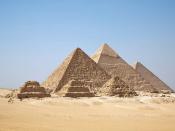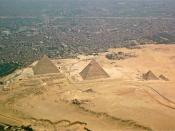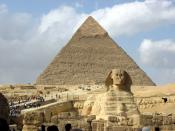The pyramids at Giza have been a mystery for people are the world for thousands of years. Perhaps the biggest mystery of the great pyramids has been who built them, and how they were built. For years the accepted hypothesis was slaves, led by slave drivers cracking whips to encourage faster work, built the pyramids. This hypothesis was changed after hieroglyphs were found telling of a pyramid town and stating the name of mayors and overseers. This discovery sparked a new quest for the answer of who built the pyramids. Archeologists started to excavate around the pyramids and found a partial answer to their question. Excavators found what they were looking for off the south end of the sphinx when they found part of what seemed to be a bakery positioned off the first paved street on the planet. The discovery still left many questions unanswered but one thing that was certain, the pyramids at Giza were built by armies of workers who spent three generations raising these massive monuments, not slaves forced to build monuments for the king that imprisoned them.
Upon further excavating of the area less than one thousand feet behind the sphinx, archaeologists found that it was not only a town that held the tens of thousands of workers quarrying, dressing, moving, and stacking giant stone blocks that became the pyramids, but it also held a huge numbers of cooks, bakers, butchers, toolmakers, woodcutters, and other troops that kept the workface going. Further excavations in the area found the cemeteries of the workers and town folk of the "lost city" of Giza, with the help of an American tourist and her clumsy horse.
On April 14, 1990 a group of tourists were touring Giza on horseback, specifically at the south end of the structure known...


